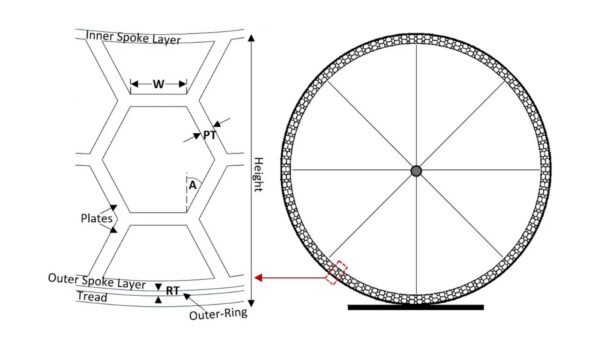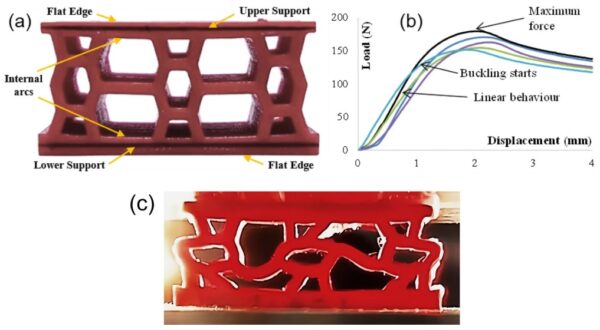Customizable, 3D-Printable Non-Pneumatic Tires for Wheelchair Use

These honeycomb flexible-spoke non-pneumatic tires (FS-NPT) bring more comfort to wheelchair users.
Pneumatic and non-pneumatic tires offer different benefits and drawbacks for wheelchair users. Pneumatic tires allow for more comfort when navigating uneven terrain, but they require frequent maintenance for their tire pressure. These tires can lose up to 40% of pressure per month and are prone to puncture. Solid non-pneumatic tires eliminate the need for this maintenance but are heavier and less comfortable. FS-NPT has yet to be used in wheelchair applications but may offer superior performance than traditional non-pneumatic and pneumatic tires. Because of the customizability of FS-NPT designs, manufacturers can tailor each wheelchair tire to its user’s individual needs.
You can also read: Inclusive Packaging: Bridging the Gap for All Consumers
Thermoplastic Polyurethane for FS-NPT Spokes
The spokes of FS-NPTs are comprised of flexible polymeric material. These deformable spokes allow for a variety of designs and customizations. A steel outer ring surrounds the spokes to maintain the tire’s circular shape. On the edge of the ring, a thin rubber tread provides traction for the tire. FS-NPTs have use in a variety of industries, including automotive, aerospace, and military.

An FS-NPT tire is comprised of three distinct layers. Figure adapted from A flexible-spoke non-pneumatic tyre for manual wheelchairs.
Researchers created a preliminary model of an FS-NPT specifically for wheelchair use. They selected a 3D-printable thermoplastic polyurethane (TPU95A) as the material for the tire’s spokes. When designing a FS-NPT, adjusting parameters such as spoke count and ring thickness affect the tire’s performance. The researchers found that increasing the thickness of the plates that make up the honeycomb layer strengthened the tire overall. This adjustment increased the tire’s vertical and rotational stiffness while reducing spoke stresses. Increasing the number of spokes also resulted in a stronger tire.
When increasing the tire’s parameters by 10% of their acceptable range, the researchers observed the following changes:
| Parameter | Vertical Stiffness (%kN/m) | Rotational Stiffness (%Nm/deg) | Stress Reduction (%kPA) |
| Plate Thickness | +8.7 | +172.3 | -1.9 |
| Spoke Count | +2.8 | +55 | -1.6 |
| Ring Thickness | +3.2 | +28.5 | -1.0 |
| Angle | -9.8 | +71.4 | -3. |
Designing With Users in Mind
When designing wheelchairs, it is important to keep mass as low as possible. Heavier tires require more energy to overcome inertia and increase the rolling resistance. Additionally, heavier tires make it more difficult for the user to dismantle and transport their wheelchair.
Increasing the thickness of the plates had the strongest strengthening effect on the tires. Nevertheless, when considering the tire’s mass, increasing spoke count is the more efficient approach. The researchers observed the following changes for every one gram of mass added to the tire:
| Parameter | Vertical Stiffness (kN/m) | Rotational Stiffness (Nm/deg) | Stress Reduction (kPa) |
| Plate Thickness | +1.6 | +7.3 | -59 |
| Spoke Count | +2.0 | +9.4 | -200 |
The final design had a 1.25 plate thickness, 3 mm spoke width, 25° angle, and 106 spokes. The final ring thickness was 0.25 mm.

Researchers evaluated the material’s compression using a 3D-printed tire sample. Courtesy of A flexible-spoke non-pneumatic tyre for manual wheelchairs.
FS-NPTs could allow manufacturers to design tires that exhibit various levels of vertical stiffness. Thus, they can create a tire that is relatively stiff under a vertical force similar to the user’s body weight. More cushioning provides more comfort during pavement dismount or when rolling over a bump. In these events, the FS-NPT becomes softer, reducing shock. By leveraging this technology, these tires can enable maximum wheeling efficiency, maximum shock absorption, and optimum cushioning.
